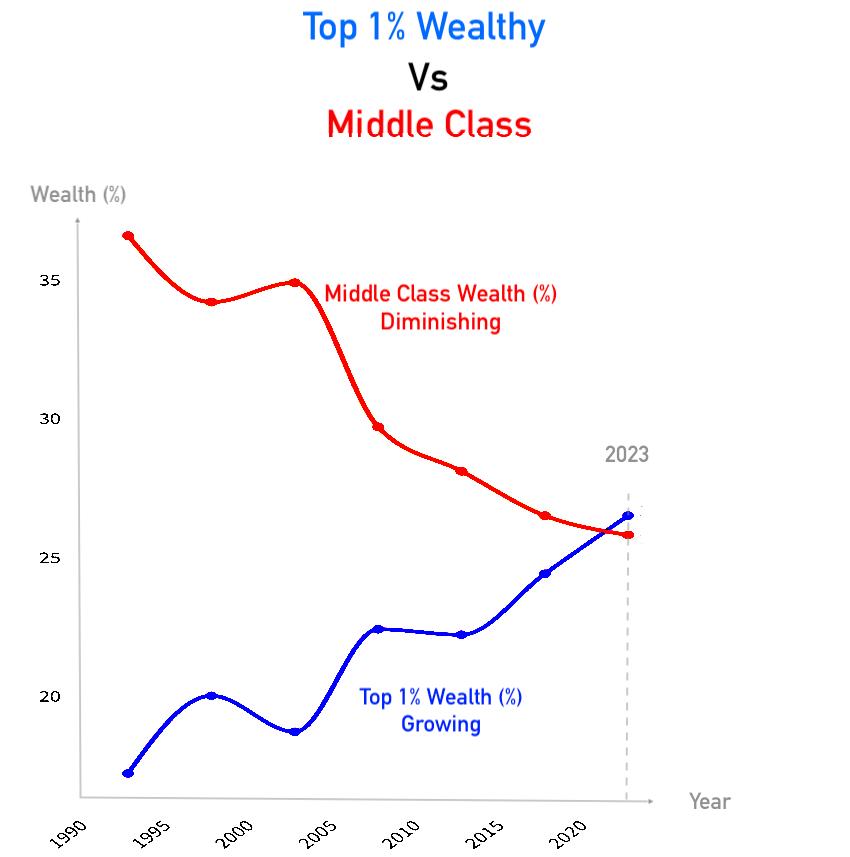-
Новости
- ИССЛЕДОВАТЬ
-
Статьи пользователей
The Wealth Gap Widens: A Tale of Two Percentages

In the complex landscape of economic distribution, numbers often tell stories that words struggle to articulate. Such is the case with a striking line graph depicting the evolving wealth distribution between the top 1% of U.S. earners and the middle class from 1993 to 2023. This graph, more than mere lines and percentages, encapsulates the profound shifts in wealth ownership and the ramifications they hold for society at large.
1993
In 1993, the top 1% of earners commanded an imposing portion of the nation's wealth, towering at over 35%. However, this dominance gradually waned in the subsequent years, marking a slight decline until the early 2000s. At this juncture, the narrative took an unexpected turn. Rather than a continuous decline, the graph reveals a resurgence, an upward trajectory that defies conventional expectations.
2013
Around 2013, the pace of ascent for the top 1% accelerated, almost startlingly so. What could have spurred such a rapid accumulation of wealth within this elite echelon? The reasons are manifold, ranging from favorable tax policies to the exponential growth of certain sectors in the economy, catalyzing the expansion of fortunes for the fortunate few.
2020
The watershed moment arrives in 2020, a year marked by seismic shifts in societal dynamics. The graph illustrates a pivotal crossover: the top 1% now commands a greater share of wealth than the middle class—a milestone laden with significance. It's a stark indicator of the deepening chasm between the haves and have-nots, a visual testament to the burgeoning wealth inequality that plagues contemporary America.
The implications of this profound redistribution are far-reaching and multi-faceted. Economically, it underscores the consolidation of power and resources among a select few, exacerbating disparities in access to opportunities and resources. Socially, it breeds discontent and disillusionment, fostering a sense of alienation and resentment among those relegated to the margins of prosperity.
Furthermore, the ramifications extend into the political realm, where wealth often translates into influence and leverage. The burgeoning power wielded by the top 1% has the potential to skew policy agendas, perpetuating a vicious cycle of privilege and exclusion that undermines the democratic ideals upon which the nation was founded.
Perhaps most disconcerting is the sheer velocity of the top 1%'s ascent, particularly in the latter half of the examined period. The abrupt surge around 2013 serves as a stark reminder of the fragility of economic equilibrium and the vulnerability of those teetering on the precipice of financial stability.
2023
To contextualize these figures, it's imperative to grasp the staggering thresholds that delineate the upper echelons of American society. In 2023, membership in the top 1% necessitated an annual income surpassing $652,657—a sum that eclipses the lifetime earnings of many hardworking individuals striving to make ends meet.
Gap
The line graph documenting the evolving wealth distribution between the top 1% and the middle class serves as more than a statistical artifact; it's a mirror reflecting the stark realities of contemporary American capitalism. As the chasm widens and the disparities deepen, the imperative for equitable reform becomes ever more urgent—a call to action resonating far beyond the confines of mere numbers and percentages.
- Aspiration
- Banking
- Bitcoin
- Blockchain
- Centralization
- Crypto Asset
- Decentralization
- Образование
- Fiat Currency
- Inspirational
- SATS
- Technology
- Trade
- Traditional Finance
- Web 3
- Web 5
- Web/Cyber
- Web/Cyber/Hack
- Web Evolution
- Web/Internet
- Web/Wellness
- Web/Internet/Other


